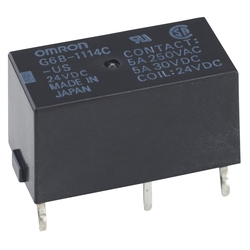(!)NOTE : Windows 7 users won’t be able to use some latest features of eCatalog/WOS since Microsoft is ending support for Windows 7 on 14 Jan, 2020. Please upgrade your system for uninterrupted services.
- Scheduled Maintenance Notice: This site will be unavailable due to scheduled maintenance from 6:30 24/11/2024 to 4:30 (IST) 25/11/2024. We apologize for the inconvenience.
- Please note that the MISUMI Pune office and warehouse will be closed on November 20th due to the state election.
- Notice of End of Sales for Economy Series Pneumatic Equipment Category. More information.
Power Relays(Latch function:Available)
Brand |
|
|---|---|
| CAD |
|
| Days to Ship |
|
1 items
- Sort By
-
You can add up to 6 items per a category to the compare list.

OMRON
[Features]
· A high capacity, highly pressure-resistant sealed structure. Small 1a contact 5 A (8 A), 1a1b, 2a, 2b contact 5 A power types.
· Boasts a power consumption of just 98mW and high level of sensitivity (G6B-1114P-US, G6B-1174P-US).
· Highly insulated with a withstand voltage of AC3,000V (impulse withstand voltage of 6kV) between coil-contacts.
· Employs stick wrapping in view of use with automated product lines.
· The standard type is UL508 and CSA standard certified.
· SEV standard-certified products also available.
· The series also includes types with FD contacts (AgSnln) which are suitable for loads that generate surge voltages
· (inductive loads and capacitative loads, etc).
· The series includes types that support ultrasonic cleaning.
· The series includes types with built-in operational display lights + surge absorbing diodes.
· The series also includes two pole types.- Volume Discount
Application Contact Configuration Latch function Terminal shape Contact rated current (minimum value for AC and DC)(A) Coil rated voltage (DC)(V) Coil rated voltage (AC)(V) Representative Standard Dimension height(mm) Dimension width(mm) Dimension depth(mm) Power 1a Available For Circuit Boards 5 24 - UL / TUV / CSA 10 10 20 From: ₹ 689.00 Days to Ship: Same day  Same day
Same day
| Brand |
|---|
| Product Series |
| From |
| Days to Ship |
| Application |
| Contact Configuration |
| Latch function |
| Terminal shape |
| Contact rated current (minimum value for AC and DC)(A) |
| Coil rated voltage (DC)(V) |
| Coil rated voltage (AC)(V) |
| Representative Standard |
| Dimension height(mm) |
| Dimension width(mm) |
| Dimension depth(mm) |
You can add up to 6 items per a category to the compare list. | |
| Brand | OMRON |
| Product Series | |
| From | ₹ 689.00 |
| Days to Ship | Same day |
| Application | Power |
| Contact Configuration | 1a |
| Latch function | Available |
| Terminal shape | For Circuit Boards |
| Contact rated current (minimum value for AC and DC)(A) | 5 |
| Coil rated voltage (DC)(V) | 24 |
| Coil rated voltage (AC)(V) | - |
| Representative Standard | UL / TUV / CSA |
| Dimension height(mm) | 10 |
| Dimension width(mm) | 10 |
| Dimension depth(mm) | 20 |
Loading...
Configure
Specification/Dimensions
-
Application
- Power
-
Contact Configuration
-
Latch function
- Available
- NA
-
Terminal shape
- Socket / plug-in
- For Circuit Boards
- Tab Terminal
-
Contact rated current (minimum value for AC and DC)(A)
-
Coil rated voltage (DC)(V)
-
Coil rated voltage (AC)(V)
-
Representative Standard
- UL
- TUV
- CSA
-
Dimension height(mm)
-
Dimension width(mm)
-
Dimension depth(mm)
Related Categories to Power Relays
FAQ Power Relays
- Question: What are power relays and how do they function?
- Answer: Power relays are electromechanical devices that control high-power circuits using a low-power input. They consist of a coil and one or more sets of contacts. When the coil is energized, it creates a magnetic field, causing the contacts to close or open, thereby controlling the flow of electrical power.
- Question: How do power relays differ from other types of relays?
- Answer: Power relays are specialized for handling higher currents and voltages compared to other relays. They are designed to manage heavy loads in industrial applications, making them distinct from signal relays or low-power relays used in electronics.
- Question: What should be considered when selecting a power relay for an application?
- Answer: Consider the voltage and current ratings of the load, the relay's switching capacity, environmental conditions, and the required contact configuration. Also, assess factors like the reliability and lifecycle of the relay to ensure it meets the specific needs of the application.
- Question: What are the main applications of power relays?
- Answer: Power relays are used in various industries for tasks such as controlling motors, heaters, lighting systems, and other high-power devices. They are crucial in automation, machinery, and energy management systems.
- Question: What are the voltage and power load capacities of power relays?
- Answer: The voltage and power load capacities of power relays vary based on their design and intended application. Common voltage ratings range from 12V to 240V, and power load capacities can extend from a few watts to several kilowatts, depending on the relay type and configuration. Always check the datasheet for specific details relevant to the chosen relay.






How can we improve?
How can we improve?
Thank you for your time.
Your feedback is essential for our continuous improvement
Privacy Policy
Thank you for your cooperation.
Thank you for your time.
Your feedback is essential for our continuous improvement
Please use the inquiry form.
Privacy Policy